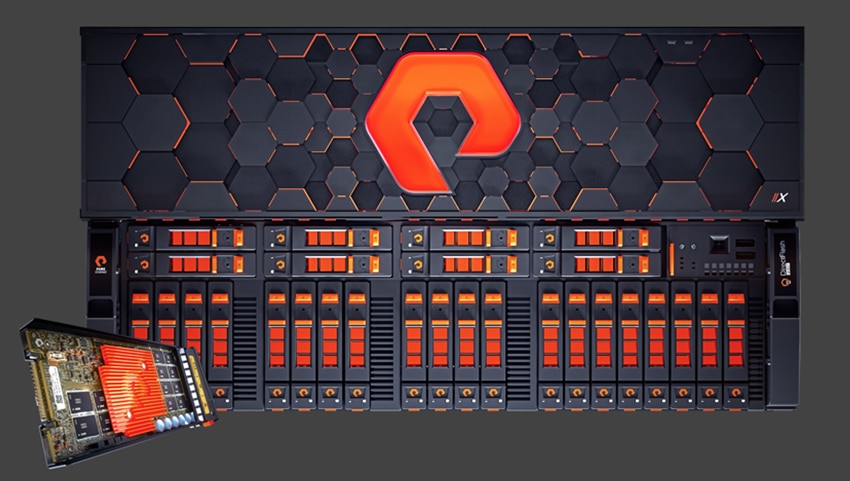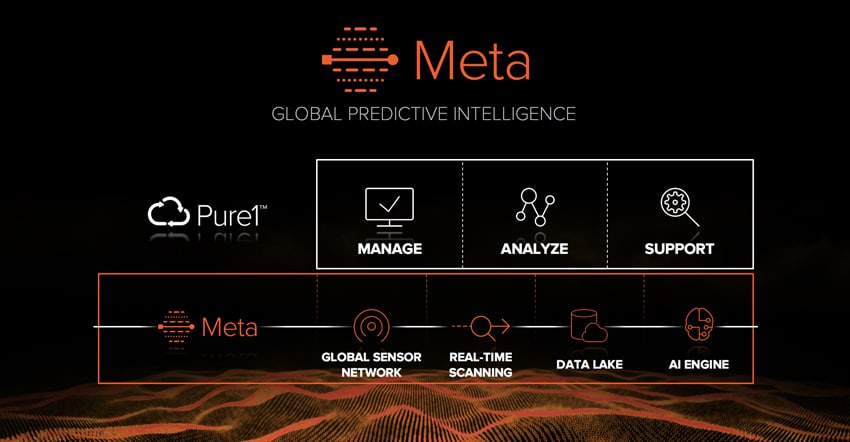
At Pure Storage Accelerate 2017, the company made several announcements. These announcements include new software and hardware innovations to “redefine Tier 1 storage for the cloud era.” The company updated its FlashBlade blade system for higher performance and capacity. And Pure announced its artificial intelligence (AI) platform, Pure1 META.
Tier 1 storage is where the fastest and most reliable storage needs to sit. This is, after all, where the most business critical data will reside and is typically all-flash. As the cloud era has rolled out, Tier 1 storage needs to be flexible so it can adapt to a changing environment. With this in mind, Pure released Purity//FA 5.0 to help customers keep up in the cloud era. At the heart of Purity//FA 5.0 is AcitveCluster an active/active metro stretch cluster solution. ActiveCluster is designed to be simple with the ability to be configured in minutes. It is fully integrated into FlashArray with no need for an add-on gateway.
Purity//FA 5.0 features include:
- Policy-Based QoS. QoS is essential for consolidating multiple tiers of workloads onto a single FlashArray, or implementing Service Provider business models. Purity’s ultra-simple, Always-On QoS is extended in this release to include sophisticated policy management, which enables customers to define Bronze/Silver/Gold tiers of workloads for worry-free consolidation, or add per-workload limits for Service Providers to enable differential billing.
- Purity CloudSnap. Customers have increasingly leveraged the public cloud for low-cost backup, retention, DR, and to enable agile application development workflows. FlashArray introduces Purity CloudSnap, a new capability for moving snapshots to and from the public cloud. First, supporting Amazon Web Services (AWS), CloudSnap enables snapshot backup to S3 and Glacier, with recovery options into EBS or back to FlashArray. CloudSnap can restore customer’s data in the public using the cloud’s native storage formats, which enables full use of public cloud PaaS services. CloudSnap represents Pure’s first step to much deeper public cloud integration within Purity.
- Snap to FlashBlade and NFS. Purity’s Snap technology has been greatly enhanced to seamlessly move data copies off FlashArray for long-term retention. The feature uses a new Portable Snapshot format which encapsulates recovery metadata within the Snapshot. Purity Snapshots can now seamlessly be moved to FlashBlade or any NFS target for long-term retention. The migration and recovery is seamlessly managed within Purity’s snapshot management policies, which enables snapshot retention on open, lower-cost media options.
- VMware VVols. Designed for cloud automation, VMware VVols and storage policy-based management bring automation and compliance to VMware-based clouds. Pure’s VVols implementation offers new levels of simplicity and hosts the VASA provider right on the FlashArray, which enables accelerated VMFS → VVols conversion, and enabling simple P→V and V→P migrations.
- Purity Run. Now, Pure offers an array that also serves as an open platform to run custom code, extend interfaces, and enable analytic processing to happen where data is stored. Purity Run enables customers to host VMs and Containers on the FlashArray itself, which opens up new avenues for extensibility and integration. Purity Run creates a safe, dedicated, performance-and-security-isolated CPU and Memory space to run customer code, and supports use cases for Edge, remote office, analytic and database appliances.
- Windows File Services for Purity. Many FlashArray customers want to consolidate point SMB and NFS file shares onto FlashArray. Purity Run now integrates with Windows File Services (WFS) bringing best-of-breed SMB 2/3 and NFS 3/4 protocols onto FlashArray. WFS, fully integrated and optimized for FlashArray, is fully supported by Pure Storage, and can be easily managed with the native Microsoft management stack.
- Microsoft ODX. Integration with the Offloaded Data Transfer (ODX) API brings fast, transparent, automatic data copy and move services for files and VMs, onto FlashArray. By offloading the data transfer to the storage array, our ODX implementation minimizes latencies, maximizes array throughput, and reduces resource usage such as CPU and network consumption on the host systems.
- Docker Persistent Volumes. With container technology increasing in mainstream adoption, there is an immediate customer need to deliver persistent storage for containerized applications. With Certified Docker Volume Plugin for FlashArray, customers can extend the benefits of all-flash shared storage to their new containerized applications. The Pure Storage integration brings persistent storage to the docker ecosystem that extends to orchestrators like Swarm, Kubernetes and Openshift.
- Compression 2.0. Purity//FA 5.0 boosts Purity’s already market-leading data reduction with an additional 25 percent improvement in compression effectiveness, and further improves all-flash cost efficiency for database and application workloads. All of this is made possible by the introduction of new self-selecting compression algorithms to match the most appropriate data sets.
- 2X Performance Improvements. Purity//FA 5.0 caps off a year of steady improvements in write performance for FlashArray, delivering up to a 2X improvement in write throughput, available to all FlashArray customers as a simple non-disruptive software upgrade.
Along with the software upgrades, Pure is also releasing an all-NVMe DirectFlash Shelf. As an expansion of the all-NVMe FlashArray//X, this new shelf allows users to expand beyond the base chassis over a dedicated 50 Gb/S RoCE v2 NVMe/F fabric.
Pure has updated its FlashBlade making it five times larger (from a capacity standpoint not footprint) and five times faster. Users will now be able to manage up to 75 blades as a single system. And the company has added a 17TB blade to its existing line up of 8TB and 52TB blades. The 75 blades along with the new blade option enable a maximum effective capacity of 8PB.
To make good on their “Self-Driving Storage” vision, Pure is also introducing the Pure1 META AI platform. According to the company, Pure1 META can deliver global predictive intelligence by collecting and analyzing over 1 trillion array telemetry data points per day and enables effortless management, analytics and support. Pure goes on to state, Pure1 META “analyzes a data lake of more than 7 petabytes of data to generate both Issue Fingerprints and Workload DNA. META scans all incoming array telemetry against a library of issue fingerprints to predict and resolve incidents in real-time, before they impact customer environments, and captures hundreds of variables related to performance that are used to forecast performance load.”
Sign up for the StorageReview newsletter



